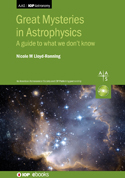Great Mysteries in Astrophysics
Editorial: IOP
Licencia: Creative Commons (by)
Autor(es): Nicole M Lloyd-Ronning
What are the key things we don’t know about our universe and what are we doing to
solve these great mysteries?
This book stemmed from a class I taught at the University of New Mexico, Los
Alamos, for about 5 years through their Community Education Program. Called
“Modern Astrophysics for Everyone,” it was intended to highlight current, unsolved
problems in astrophysics, and it was open to absolutely everyone, regardless of age,
background, education level, training, etc. Indeed we had a huge range of learners—
from high schoolers to retirees, from those with no background at all in physics to
those with PhDs in physics who had spent their lives dedicated to technical research.
Somehow and amazingly, it seemed as if everyone got something from the class
(without question, everyone certainly contributed to the class!). This book is
intended in that same spirit—hopefully written in a way such that those with no
background, as well as those with training in a technical field, might get something
out of it.
Because a problem cannot be solved until one really understands what needs to be
solved, this book aims to clarify what it is that we do not understand in our current
picture of the universe. Articles and other publications centered on scientific topics—
whether in academic journals or in the popular media—are often focused on
discovery, reporting on an exciting experimental or observational breakthrough.
Additionally, there are many popular science books and technical textbooks that do
a great job of summarizing what we (think we) do know. Here, we do the opposite—
highlighting where we are missing something big and fundamental in our pursuit to
understand the objects in, and behavior of, our universe. After briefly describing
approaches to solving scientific problems as well as how astronomers “see” or gather
information from space, the book will describe several areas where our knowledge is
glaringly incomplete: dark matter, dark energy, the Hubble constant, the formation
of the first stars in our universe, binary/multiple systems, deaths of massive stars,
mysteries associated with neutron stars, black holes, and beyond. This book intends
to take a big-picture approach to these exciting mysteries, presenting them at what I
hope is a level that doesn’t require a lot of background knowledge (but with
additional technical explanation in insets and plenty of references for further
exploration). Each chapter will give a summary of the state of knowledge in a
particular astrophysics research area and then proceed to explain where the
mysteries lie—where we have new territory to explore and much to learn.
An additional aim of this book is to make clear that understanding the physics of
our fascinating universe is an ongoing pursuit, a pursuit that is (or should be)
accessible to everyone, and one that needs all of us participating!
Compartir:
Una vez que el usuario haya visto al menos un documento, este fragmento será visible.


